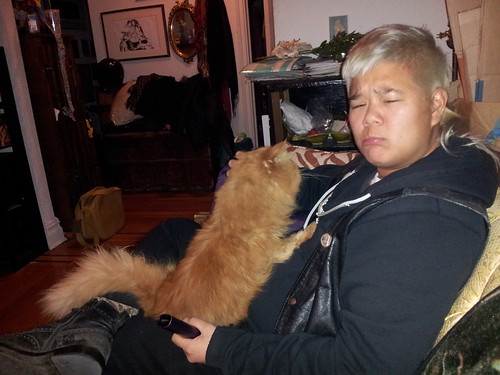I have three things to share with you today that I’m pretty excited about. The first is an article I wrote for Autostraddle to celebrate the launch of their fancy new redesign! It’s all about marriage rights for queers and how marriage isn’t our only option.
“Marriage is like a chlorinated community pool that we now have access to. I think that people forget that queers have been swimming in the ocean the whole time. We have always had to be creative about how we create our love relationships and, now that we don’t have to be creative, I hope we still can be.”

This dress is the closest thing I have to a wedding gown right now and I love it so deeply. Gratuitous shots of two of my favorite people and heroes, Barbara Carrellas and Kate Bornstein. The documentary about Kate is available to tour to schools and festivals, get in touch with Sam the director–I saw it last weekend and it is phenomenal.
The second thing is that it is December 17th, International Day to End Violence Against Sex Workers. It’s a day of remembrance and solidarity for folks lost this year. Sex work is work, and it can be extremely dangerous as media, laws and other social constructs create a society in which sex workers are not seen as people who deserve protection and are disposable. Working to legalize sex work is something I’ve been interested in since I was in law school over a decade ago. Right now I work with Desiree Alliance, an organization that brings together harm reduction, direct services, political advocacy and health services for sex workers.

Me and Jacqueline at the Desiree Alliance Conference last summer. The next one is in the Summer of 2015.
To borrow from my friend Fancy Feast, who says it so eloquently:
I would be nowhere without the sex workers in my life. Today and every day we need to be doing what we can as allies and advocates to make their work safer. That means all sex workers everywhere, not just the white ones, not just the cis ones, not just the ones with college degrees. Every. Last. One of them.
You can learn more about December 17th events and projects here.
The third link I wanted to share was this article about Supporting a Loved One Through PTSD or Panic Attacks. I’ve been going through a lot lately both on my own level with many deaths (three in total) and then also as a caretaker and supporter of a person with breast cancer. As of this morning, I’m maybe going through the process of putting down my other cat (I put down Bear six months ago). It’s a lot! And the last three weeks have been kind of a huge emotional roller coaster. I’ve been thinking a lot about what makes a difference in care and support and I liked this article and thought it might be useful for folks who look at someone going through a hard time and wonder what to do. For me, right now, it’s just folks being there and being willing to listen.
Often in the midst of the episode, the distressed person doesn’t necessarily have their full vocabulary and can’t articulate exactly what they need in that moment. Afterwards, they may avoid talking about it out of embarrassment, fear, or a desire to preserve the peacefulness of the present.
So how do you learn what is helpful?
If you’re like my partner, mostly through trial and error. However, this cartoon inspired me to draw up a list of tips, taking from my own preferences as well as those of some friends. They’re not universal, but they’re a starting point, I think, for the right mindset.

